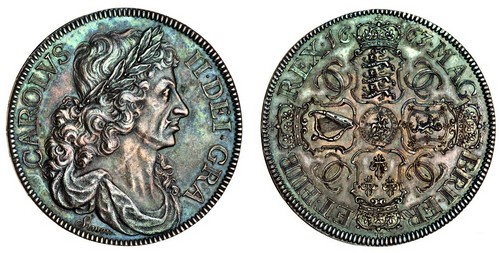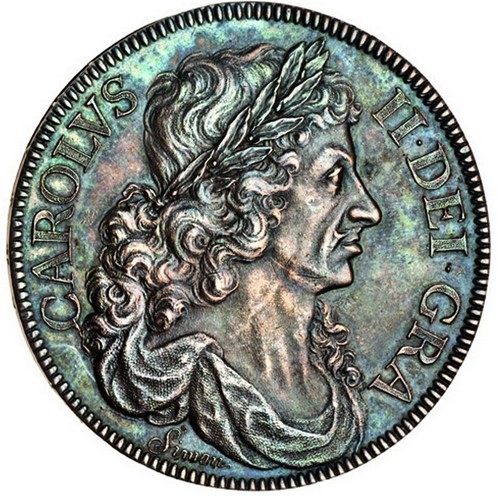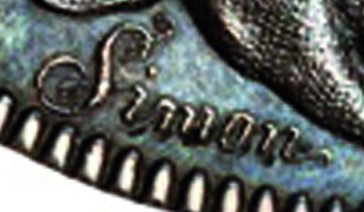Auction: 14004 - Ancient, British and Foreign Coins and Commemorative Medals
Lot: 1627
Charles II, pattern Crown, 32.94g, 1663, the 'Reddite' Crown by Thomas Simon, large laureate and draped bust of fine style facing right, struck in high relief, signature, simon, below, carolvs ii. dei. gra, toothed border both sides, rev. struck en medaille, crowned cruciform shields arranged around insignia of the Order of the Garter, twelve strings to the Irish harp, interlinked c's in each angle, date either side of crown above English shield, .mag bri. fr et. hib rex. 1663, edge lettered in relief with square capitals, reddite . qvae . cæsaris . cæsari &ct. post, radiant sun emerging from behind cloud, a very clear band ending through the cloud (ESC 73; L&S 7; Bergne, NC 1854, p.143, number 6; S.3354B), die flaw from c of carolvs extending past lowest curl to drapery, 'ghosting' from striking visible, particularly on the reverse, faint old marks on jaw (as described in the 1897 Montagu sale catalogue), good extremely fine with an attractive even grey tone, the finest known example of this important coin, extremely rare
provenance
H.M. Lingford, part I, Glendining, 24 October 1950, lot 269, described as 'The finest known specimen, in brilliant state and even rarer than the 'Petition' crown' (£360)
Virgil Brand, collection dispersed after 1932
J.G. Murdoch, Sotheby, 8-13 June 1903, lot 641, described as 'in almost perfect preservation, finely toned and of the highest rarity, probably the finest known.' Purchased by Spink for £215.
H.M. Montagu, Sotheby, 18-23 November 1897, lot 833, 'beautiful state and probably the finest known'. In a footnote the cataloguer discusses the provenance and comments, 'Again, Mr Bergne (Num. Chron. vol. XVI, p.143), describes this coin as 'in good condition'. This gives it but scanty praise, whereas but for two or three slight and almost imperceptible scratches on the king's face, the coin is in perfect condition.' Purchased by Spink for £100.
W. Brice collection, collection acquired en bloc by Hyman Montagu, 1887
G. Sparkes, Sotheby, 2 February 1880, lot 157, purchased by W. Webster for William Brice
Acquired by George Sparkes from H. Wigan in exchange for the Thomas specimen (the Thomas specimen listed by Bergne, no. 4)
J.D. Cuff, Sotheby, 26 June-3 July 1854, lot 1374 , 'in the finest state of preservation,' purchased by Cureton for Henry Wigan (£74)
Abraham Edmonds, Sotheby, 24-26 March 1834, lot 159, 'highly preserved and extremely rare', acquired by Young for J.D. Cuff (£42)
Abraham Edmonds, purchased privately from Trattle
Marmaduke Trattle, purchased privately from Miles
W. Bootle, sold privately to Miles
Thomas Selbye, Langford,18 December 1755, lot 21, acquired by Wilbraham Bootle
THE NEW MILLED COINAGE OF 1662
In May 1662 Thomas Simon lost out to John Roettiers in his efforts to be appointed Chief Engraver at the Royal Mint. Charles II commanded Roettiers, not Simon, to prepare 'all master puncheons, letters and charges for silver and gold coins to be made by mill and press and to make dies for coining according to directions.'
A mint report of 13 April 1662 tells us that there had already been a 'contest of the art' between Simon and Roettiers. The same report tells us that Blondeau was 'to make all gold and silver pieces round before they are sized and to make the edges of all the Gold and Silver coins with letters or Grainings, according to their respective size before they are stamped on their flat sides' He was also to 'prepare Rings of Viroles of Steel for making the edges for the Several coins with letters and grainings.' Charles II appears to have been taking a direct interest in this as the same mint report notes 'The said Blondeau is to discover his Secrets in rounding the pieces before they are sized and in marking the Edges of the Moneys with letters and graining unto His Majesty if he should please to doe him the honour of being witness unto his Art and Inventions.'
The Roettiers, experienced in the practicalities of producing coins by machine, and with the added benefit of their trusted and skillful smith, Peter Jansen, had used the new machinery to produce pattern Crowns, which the king had approved. Now they immediately set to work, and the first new milled coins, dated 1662, were produced late in the year. However, these did not find universal favour, and the quartered arms in the upper and lower shields on the reverse came in for particular criticism. As a result a new design was described by an order dated 8 April 1663. This replaced the quartered shields with the arms of England and the arms of Scotland in the upper and lower shields respectively.
This change seems to have prompted Simon to turn his thoughts once again to producing his own pattern for the Crowns.
THE PETITION AND REDDITE CROWNS OF 1663
Simon used this opportunity to produce his superb pattern Crowns, embellished with remarkable edge inscriptions:
- A long inscription in English, in two lines, in which he made his famous petition to the king;
'thomas simon most hvmbly prays yovr majesty to compare this his tryall piece with the dvtch and if more trvly drawn & emboss'd more grace: fvlly order'd and more accvrately engraven to releive him.' This is known as the Petition Crown.
- An inscription in Latin, in one line, 'reddite quæ cæsaris cæsari &ct post' (Render unto Caesar the things which are Caesar's etc'). The word 'post' precedes a pictured motif of the sun appearing from behind a cloud. This stands for 'post nubila Phoebus' (the sun shines after the storm). This is known as the Reddite Crown.
The Petition version seems intended to demonstrate the level of detail that might be achieved with the lettering, the inscription being very long, in two lines, and the letters being in two sizes and in two very different styles. Such a complex edge was of course impractical for a coin. The Reddite version, in one line, is more practical, while also demonstrating the ability to add an image (the sun and clouds) in addition to the lettering. A third, English, inscription 'render to caesar the things which are caesars' is also known but only in pewter. It is possible these were experimental designs which were rejected for use in the exhibition to the king. The results displayed Blondeau's skill to the full and allowed Simon an opportunity, at last, to show the King his design for a Crown piece.
The Reddite and Petition Crowns are both struck from the same pair of dies with the only difference between them the edge inscription. The obverse design prepared by Simon was presumably based on a portrait of the king by Samuel Cooper, the celebrated miniaturist, versions of which were made available to both Roettier and Simon sometime in 1662. Simon used this to engrave his remarkable portrait which he signed in full beneath the bust, a most unusual practice in the seventeenth century. The reverse die, with the revised arms around a detailed St George, and dated 1663, must have been cut after the 8 April 1663 order, suggesting that certainly this reverse die, and possibly also this obverse die, were prepared specifically for these exhibit strikings.
The resulting 'Petition' and 'Reddite' Crowns have long been admired as masterpieces of the engravers' art and among the most desirable coins of the entire English series. Though the Roettier brothers continued to produce the dies for the Crowns, the influence of these patterns by Simon can clearly be seen, particularly in the revised portrait that appeared in 1664 which is strongly reminiscent of Simon's ground-breaking portrait.
It is thought that no more than thirty examples, of all types and in all metals, have survived. Exact numbers of each are hard to qualify. The earliest listing is that provided by Bergne in the 1854 Numismatic Chronicle, and this list, supplemented by Linecar and Stone in 1968, forms the main source for identification.
Five examples of the Reddite in silver can be stated to exist with confidence, making the Reddite much rarer than the Petition.
1. The Glenister, first recorded in the collection of Thomas Selbye, sold in 1755, subsequently Cuff, passing through other hands to Montagu, Murdoch and via Brand to Lingford (Bergne no. 6). It is then acquired by Glenister at the Lingford sale in 1950, no doubt to accompany his equally superb Petition Crown, purchased in December 1944 (Glenister part I, Spink auction 190, 27 September 2007, lot 503)
2. The Whitehead, sold in 1898, described as 'most beautiful state' and first recorded in the collection of Mr. West sold in 1773, subsequently passing through the Tyssen, Trattle and Thomas collections (Bergne no. 4).
3. The Sloan, from the collection of Sir Hans Sloan, on his death going to the British Museum who sold it as a duplicate in 1811. It subsequently passed through the Brice, Murchison, and Addington collections, passing to Montagu who sold it in 1888. This later passed through the Nightingale, Willis and LaRiviere collections, recently resurfacing at auction in London in February 2013, described as 'good very fine...the second finest available.' (Bergne no. 5)
4. The Oxford, sold in 1742, later Tyssen and Roberts and now in the British Museum (Bergne no. 1)
5. The Lindgren, sold in 1784, later in the collection of Miss Sarah Sophia Banks. On her death in 1818 her extensive collections were immediately bequeathed by her brother, Sir Joseph Banks, to the British Museum, and divided between the Museum, the British Library, and the Royal Mint Museum. The British Museum already had examples of both the Petition and Reddite Crowns, and so these two coins, among others, were allocated to the newly established Royal Mint Museum. (Bergne no. 2)
In addition Bergne listed four other examples in silver, none of which can be verified (no. 3, Bodleian Library, Oxford, 'nothing known of this specimen but that it is described as being in fine condition'; no. 8, Mr. Bergne, Foreign Office, 'bought of a lady in 1836, in indifferent condition'; no. 9, Mr. Brown, Paternoster Row, 'very poor'; and no.10, Mr Gibbs, of the Inner Temple, 'in very bad condition'). Two examples are known in pewter; Bergne no. 7, from the Cuff collection, and no. 11, from the Duke of Devonshire and Chetwynd collections.
The Glenister Reddite Crown offered here has always been considered the finest example of this very select group of Reddite Crowns. Noted in successive catalogues as 'the finest known', the Glenister piece becomes all the more significent when it is noted that, apart from the British Museum example, which can be traced to the Earl of Oxford sale in 1742, the Glenister example has the longest pedigree, reaching back over two hundred and fifty years to 1755. During the first two hundred years, from 1755 to 1950, the coin passed through at least twelve collections. The fact that this rare and beautiful coin has resided undisturbed in one collection for the last sixty years is quite remarkable.
Subject to 20% VAT on Buyer’s Premium. For more information please view Terms and Conditions for Buyers.
Sold for
£330,000











